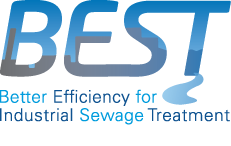7) Inhibitors in biological waste water treatment processes and testing MBBR technology for treating industrial wastewaters
Riga Technical University piloting in Project BEST
Final reports on the pilot studies
Inhibitors and indicators in biological waste water treatment processes, LINK TO THE STUDY MATERIAL
Effectiveness of moving bed biofilm reactor (MBBR) technology for industrial wastewater treatment and impact of sodium chloride on the biomass in MBBR, LINK TO THE REPORT
Summary

MBBR reactor pilot
Food – including milk, fish, and meat- processing industries generate high-strength wastewaters with e.g. highly variable nutrient, hydrogen or salt concentration resulting from various processes or for example from the disinfection of equipment. Shock loads of high salinity or other inhibitory substances may disturb biological treatment processes due to osmotic pressure shock and cell lysis, and thus, compromise effluent water quality. Laboratory scale tests were run to research inhibition of different substances.
Furthermore, there is a need to know if the biological process can withstand short-term discard of high salts solution. The experiments with the pilot scale moving bed biofilm reactor (MBBR) aimed to evaluate the effectiveness of the technology for industrial wastewater treatment and to test the effect of short-term discard of high concentration of the sodium chloride on the biomass in MBBR.
A pilot-scale MBBR was located at the dairy production “Latvijas Piens” Ltd. The procedures of the reactor operation were controlled automatically by a digital process controller. MBBR pilot was fed with industrial wastewater from dairy factory and microorganisms grew in the reactor under natural conditions on a protected surface of carriers enabling achievement of highly adapted microflora and to ensure the degradation of a high organic load from the dairy factory.
The study showed the harmful effect of the shock load of NaCl on biomass in MBBR without pre-treatment leading to nitrification and denitrification bacteria inhibition because sludge microfauna had osmotic shock and dewatering after NaCl addition. To prevent these events in the municipal WWTP, the most valuable indicator of the NaCl inhibitor influence is electrical conductivity in the effluent, as it increases with high concentration of NaCl.



